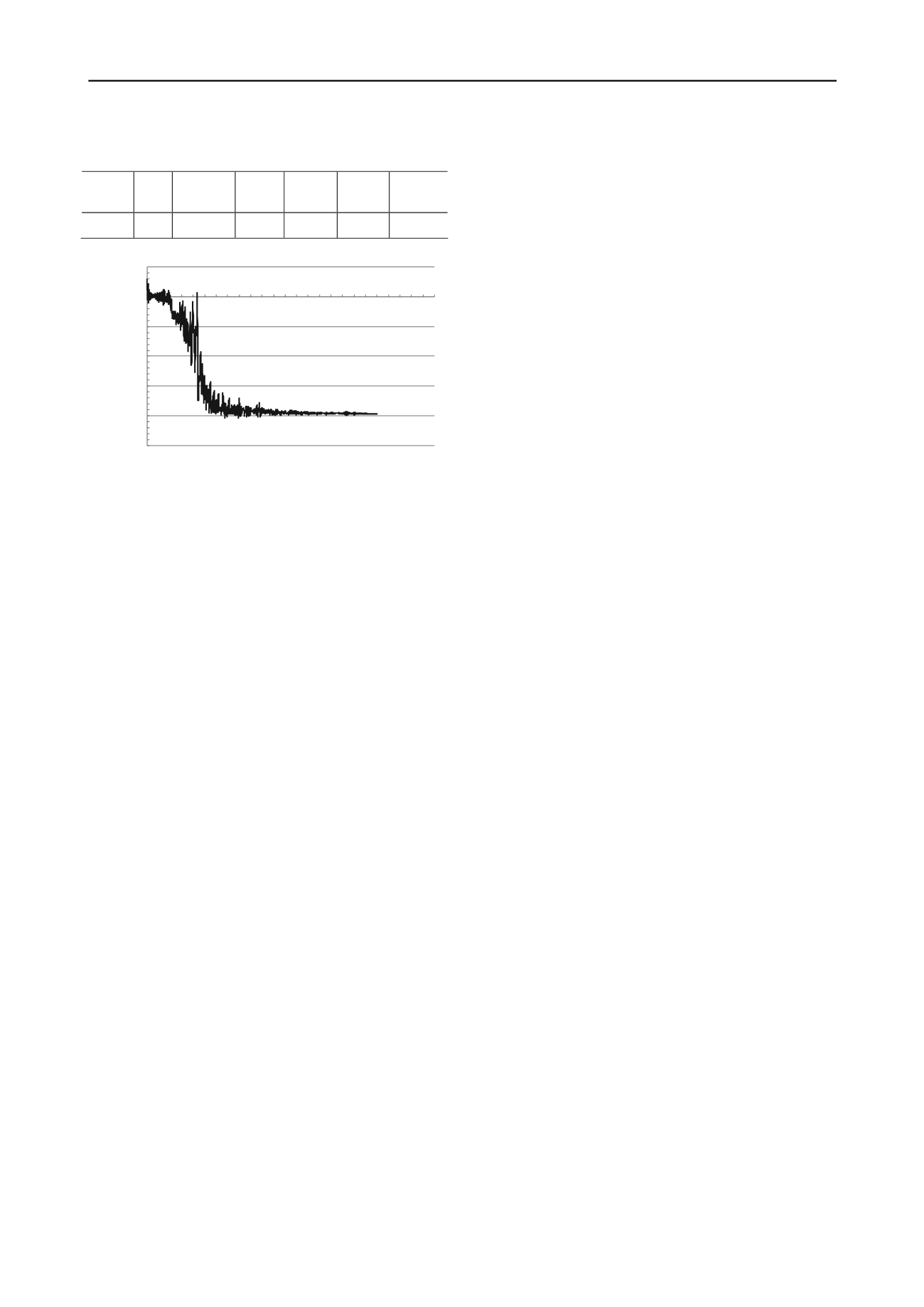
1658
Proceedings of the 18
th
International Conference on Soil Mechanics and Geotechnical Engineering, Paris 2013
Table 1. Measured maximum accelerations of the shake table and the
ackfill (the values are in g)
b
Shake
table Box Layer 1
(bottom)
Layer
2
Layer
3
Layer
4
Layer 5
(top)
1.89
1.56
1.75
1.87
1.77
2.16
2.25
Figure 7 Seismic vertical settlements of MSE wall (measured at the top
of the backfill)
Figure 7 shows the seismic vertical settlements measured by
the LVDT transducers at the top of the wall. Two LVDT
transducers were positioned at the top and they recorded
similar settlements. Therefore, only the readings from one
LVDT were shown in the figure. In the first 10 to 15 seconds, a
maximum vertical settlement of approximately 2 cm was
recorded. After that, the settlement remained at approximately
2 cm. This initial settlement could be due to the lack of
complete compaction of the TDA. Due to calibration errors, the
vertical stresses that were recorded by the dynamic soil
pressure cells in the backfill were considered incorrect and
were not presented in this paper.
4 CONCLUSIONS AND LIMITATIONS OF THIS
RESEARCH
This paper presents a preliminary experimental research on the
seismic responses of a reduced-scale geogrid-reinforced
retaining wall with TDA backfill under the simulated Loma
Prieta earthquake excitations. The research used a shake table
to produce the scaled earthquake motions. Overall the wall with
TDA backfill performed well with no apparent damage. The
maximum horizontal deflection of the wall face occurred at the
top of the wall and was 7 cm, or 4.7% of the wall height. Due
to the difficulty in achieving higher density, the TDA had a
small settlement (approximately 2 cm) in the first 10-15
seconds, or 1.3% of the wall height.
This experimental study has several limitations. (1) The
geogrid’s tensile strength was not scaled, this could result in an
over-reinforced wall. (2) The reinforcement was based on static
design. Seismic design using the methodologies presented by
Helwany et al. (2012) and by National Concrete Masonry
Association (NCMA 2010) may change the internal
configuration of the MSE wall and consequently the seismic
behavior. (3) The scaling law used in the model test should be
improved to consider the scaling of the TDA-geogrid
composite material properties. (4) External (global) stability,
such as deep-seated rotational failure that can be caused by
earthquakes, cannot be simulated in this test due to the shallow
soil depth. Because of these limitations, extrapolation of the
model results to the field is premature at this stage. This
research work is continued to address the limitations in (1), (2),
and (3). Furthermore, numerical model using Plaxis is being
developed to simulate the laboratory conditions (including the
boundary conditions, material properties, and seismic
excitations). Using the same conditions, the numerical model
can be calibrated using the model test results; then the
numerical model can be used to predict the seismic
performance of this type of retaining walls in the field.
5 ACKNOWLEDGEMENTS
This project is funded by the California Department of
Transportation, USA (agreement number: 65A0449). Steve
Scherer in the Department of Civil and Geomatics Engineering
at CSU Fresno helped the experimental setup. Mr. Cameron
Wright of West Coast Rubber Recycling (Hollister, CA)
provided the TDA; Mr. Willie Liew of Tensar International
provided the geogrid. We appreciate these supports.
-2.5
-2
-1.5
-1
-0.5
0
0.5
0
10
20
30
40
5
Vertical Displacement (cm)
Time (sec)
0
6 REFERENCES
Bosscher, P. J., Edil, T. B., and Eldin, N. N. 1992. Construction and
performance of a shredded waste tire test embankment.
Transportation Research Record
.
1345
, Transportation Research
Board, Washington, D.C., 44–52.
Federal Highway Administration, U.S. Department of Transportation.
1997. User Guidelines for Waste and Byproduct Materials in
Pavement Construction. Publication Number: FHWA-RD-97-148.
Federal Highway Administration, U.S. Department of Transportation
2008. Geosynthetic Design and Construction Guidelines
Reference Manual. Publication No. FHWA-NHI-07-092, by Holtz,
R.D., Christopher, B.R., and Berg, R.R. National Highway
Institute. Washington, DC. August 2008.
Gazetas, G. 1991 Formulas and charts for impedances of surface and
embedded foundation.
ASCE Journal of Geotechnical Engineering
,
117(9), 1363-1381.
Hazarika, H., Kohama, E., and Sugano, T. 2008. Underwater Shake
Table Tests on Waterfront Structures Protected with Tire Chips
Cushion. ASCE
J. of Geotech. and Geoenviron. Engrg
, 134(12),
1706-1719.
Helwany, S., Wu, J.T.H., and Meinholz, P. (2012). Seismic Design of
Geosynthetic-Reinforced Soil Bridge Abutments with Modular
Block Facing. Final Report for NCHRP Project 12-59 (01).
American Association of State Highway and Transportation
Officials (AASHTO), Washington, D.C.
Humphrey, D. N. 1998. Highway applications of tire shreds.
New
England Transportation Consortium Rep.
, September.
Humphrey, D. N., and Manion, W. P. 1992. Properties of tire chips for
lightweight fill.
Proc. Conj. on Grouting, Soil Improvement, and
Geosynthetics,
2 ASCE, New York, 1344-1355.
Koerner, R.M. 2005.
Designing with Geosynthetics
. fifth Edition.
Pearson Prentice Hall. Upper Saddle River, NJ.
Moncarz, P., and Krawinkler, H. 1981. Theory and application of
experimental model analysis in earthquake engineering. The John
A. Blume Earthquake Engineering Center, Stanford University. A
report on a research project sponsored by the National Science
Foundation, Grants ENV75-20036 and ENV77-14444, June 1981.
National Concrete Masonry Association (NCMA) (2010). Seismic
Design Of Segmental Retaining Walls, TEK 19-5A. National
Concrete Masonry Association, Herndon, Virginia.
Strenk, P.M., Wartman, J., Grubb, D.G., Humphrey, D.N., Natale M.F.
2007. Variability and scale-dependency of tire-derived aggregate.
ASCE J. Materials in Civil Engineering
, 19(3), 233-241.
Tandon, V., Velazco, D.A., Nazarian, S., and Picornell M. 2007.
Performance monitoring of embankments containing tire chips:
case study.
ASCE J. of Performance of Constructed Facilities
,
21(3), 207-214.
Tsang, H. H. 2008. Seismic isolation by rubber-soil-mixtures for
developing countries.
Earthquake Engineering and Structural
Dynamics
, 37, 283-303.
Tweedie, J.J., Humphrey, D.N., Sandford, T.C. 1998. Tire shreds as
lightweight retaining wall backfill: active conditions.
ASCE J.
Geotech. and Geoenvir. Eng
., 124(11), 1061-1070.


